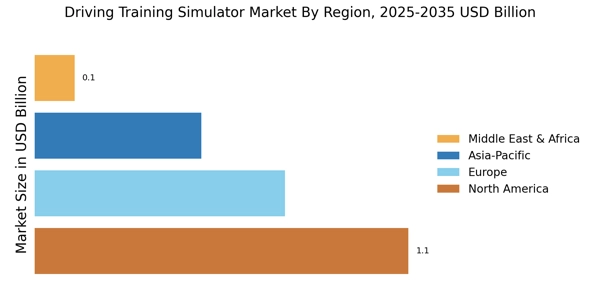The Driving Training Simulator Market is currently characterized by a dynamic competitive landscape, driven by technological advancements and an increasing emphasis on safety and efficiency in driver training. Key players such as Driving Simulation Technologies (US), Simulators International (US), and Cognitech (US) are at the forefront, each adopting distinct strategies to enhance their market positioning. Driving Simulation Technologies (US) focuses on innovation through the development of high-fidelity simulation environments, while Simulators International (US) emphasizes partnerships with educational institutions to expand its reach. Cognitech (US) appears to be leveraging digital transformation to enhance user experience, indicating a collective shift towards integrating advanced technologies in training solutions.
The market structure is moderately fragmented, with numerous players vying for market share. Key business tactics include localizing manufacturing to reduce costs and optimizing supply chains to enhance efficiency. This competitive structure allows for a diverse range of offerings, catering to various segments within the driving training sector. The influence of major players is significant, as their strategies often set benchmarks for emerging companies, thereby shaping the overall market dynamics.
In August 2025, Driving Simulation Technologies (US) announced a strategic partnership with a leading automotive manufacturer to develop customized training modules for electric vehicles. This collaboration is likely to position the company as a pioneer in the electric vehicle training segment, aligning with the industry's shift towards sustainable transportation solutions. Such initiatives not only enhance their product offerings but also strengthen their market presence in a rapidly evolving landscape.
In September 2025, Simulators International (US) launched a new cloud-based training platform aimed at enhancing accessibility for remote learners. This move is strategically important as it addresses the growing demand for flexible training solutions, particularly in regions with limited access to traditional training facilities. By embracing cloud technology, the company is likely to attract a broader customer base, thereby increasing its competitive edge.
In July 2025, Cognitech (US) unveiled an AI-driven analytics tool designed to provide real-time feedback to trainees. This innovation is indicative of the increasing integration of artificial intelligence in training simulators, which could significantly enhance the learning experience. By offering personalized insights, Cognitech is positioning itself as a leader in the market, potentially setting new standards for training effectiveness.
As of October 2025, the Driving Training Simulator Market is witnessing trends such as digitalization, sustainability, and AI integration, which are reshaping competitive dynamics. Strategic alliances are becoming increasingly prevalent, as companies recognize the value of collaboration in enhancing technological capabilities. Looking ahead, competitive differentiation is likely to evolve from traditional price-based competition to a focus on innovation, advanced technology, and supply chain reliability, suggesting a transformative shift in how companies approach market challenges.


















Leave a Comment